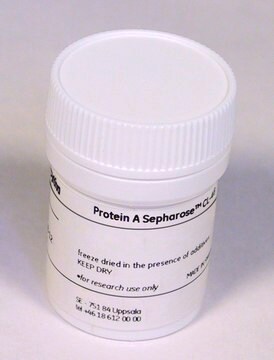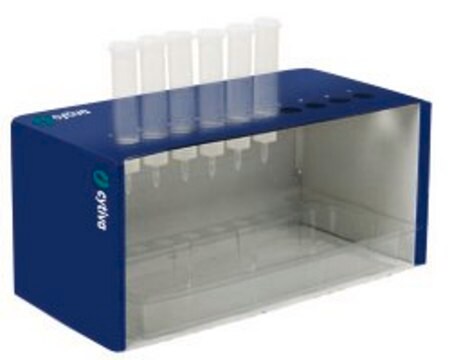GE17-0618-01
Protein G Sepharose™ 4 Fast Flow
Cytiva 17-0618-01, pack of 5 mL
Synonim(y):
Fast Flow resin, Antibody purification resin, IgG purification resin
About This Item
Polecane produkty
ligand
recombinant protein G lacking albumin-binding region
opakowanie
pack of 5 mL
producent / nazwa handlowa
Cytiva 17-0618-01
warunki przechowywania
(20% Ehtanol)
Matryca
4% cross-linked agarose
średnia średnica
90 μm (d50v)
cleaning in place
2-10
Zakres roboczy
3-9
przydatność
suitable for bioprocess medium
temp. przechowywania
2-8°C
Powiązane kategorie
Opis ogólny
Protein G Sepharose™ 4 Fast Flow has recombinant protein G immobilized by the cyanogen bromide (CNBr) method to Sepharose™ 4 Fast Flow. Protein G exhibit binding specificities that complement Protein A media and binds to the Fc region of IgG from a variety of mammalian species. Protein G Sepharose™ 4 Fast Flow may be used to isolate and purify classes, subclasses and fragments of immunoglobulins from any biological fluid or cell culture medium.
As member of the BioProcess media range, Protein G Sepharose™ 4 Fast Flow meets industrial demands with security of supply and comprehensive technical and regulatory support.
Cechy i korzyści
- Binding specificities that complement Protein A media.
- Binds a broad range of IgG species and subclasses.
- Multi-point attachment minimizes ligand leakage.
- Used in a range of research applications.
Przechowywanie i stabilność
Komentarz do analizy
Informacje prawne
produkt powiązany
Hasło ostrzegawcze
Warning
Zwroty wskazujące rodzaj zagrożenia
Zwroty wskazujące środki ostrożności
Kod klasy składowania
3 - Flammable liquids
Wybierz jedną z najnowszych wersji:
Certyfikaty analizy (CoA)
It looks like we've run into a problem, but you can still download Certificates of Analysis from our Dokumenty section.
Proszę o kontakt, jeśli potrzebna jest pomoc Obsługa Klienta
Masz już ten produkt?
Dokumenty związane z niedawno zakupionymi produktami zostały zamieszczone w Bibliotece dokumentów.
Klienci oglądali również te produkty
Produkty
This page shows a comparison of the relative binding strengths of protein G and protein A to different immunoglobulins.
Ta strona przedstawia porównanie względnej siły wiązania białka G i białka A z różnymi immunoglobulinami.
This page shows how to perform a separation with the HiTrap Protein G HP from GE Healthcare, an Affinity Exclusion Chromatography product containing pre-packed Protein G.
Protokoły
This page provides information about different pull-down assays for the further isolation of multiprotein complexes to identify their components with products from GE Healthcare.
Ta strona zawiera informacje o różnych testach pull-down do dalszej izolacji kompleksów wielobiałkowych w celu identyfikacji ich składników za pomocą produktów Cytiva.
This page shows how to separate IgG antibodies by affinity chromatography using Protein G Sepharose 4 Fast Flow from GE Healthcare.
This page shows how to separate IgG antibodies by affinity chromatography using Protein G Sepharose 4 Fast Flow from GE Healthcare.
Powiązane treści
Pull-down assays, reagents, and protocols for investigating in vitro protein-protein interactions using affinity or GST pull-down, tandem affinity purification (TAP), and co-immunoprecipitation methods.
Badanie interakcji białko-białko in vitro za pomocą testów pull-down, z wykorzystaniem metod powinowactwa, GST pull-down, TAP i koimmunoprecypitacji.
Badanie interakcji białko-białko in vitro za pomocą testów pull-down, z wykorzystaniem metod powinowactwa, GST pull-down, TAP i koimmunoprecypitacji.
Nasz zespół naukowców ma doświadczenie we wszystkich obszarach badań, w tym w naukach przyrodniczych, materiałoznawstwie, syntezie chemicznej, chromatografii, analityce i wielu innych dziedzinach.
Skontaktuj się z zespołem ds. pomocy technicznej









